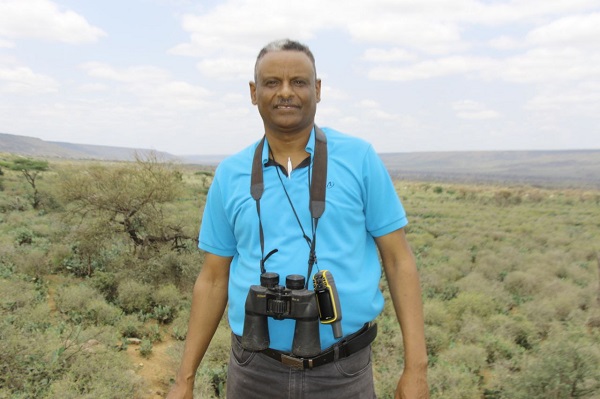
BY EPHREM ANDARGACHEW
The Babile Elephant Sanctuary is located 560km east of Addis Ababa and 25km south of the city of Harar. It is located between Oromia and Somali States. The sanctuary, in part, encompasses a plateau, the lowlands of the valleys of the Erer, Dakota, Fafen, Gobele, and Borale Rivers. It hosts a special elephant species called Loxodonta Africana Orleansi and is a tourist attraction site. Nonetheless, the sanctuary is currently in a worrisome situation.
Hence, it becomes a concern that needs serious attention and intervention to reverse the situation. During his exclusive interview with The Ethiopian Herald, Dr. Anteneh Belayneh, Biodiversity lecturer and expert at Haramaya University, elaborated on the Babile Elephant Sanctuary with a special reference to the national, regional, and global multiple benefits. Have a nice read.
Why do people call you the father of the Babile Elephant?
I was born and brought up in a place called Gursum town, in East Hararghe. My father was a soldier and often took me to Harar during my childhood. On the way to Harare, I often saw elephants around the Dakota stone.
One day, I was on a bus and got a good look at a herd of elephants crossing the road. They were tall which was even above the bus I was in. As I grew up and gained knowledge, I was enthusiastic to know about the elephant I saw as a child.
Especially, when I started my master’s degree program, the question of where are the elephants that I saw in my childhood came to my mind. After asking various questions, I found out that the Babile Sanctuary had been prepared for them and they were living there. And I made the Sanctuary a topic for my MSc Thesis to get more knowledge about biodiversity and elephants. At the time, I wrote my Master’s Thesis with a man who came from abroad for his Ph.D. dissertation.
Since I loved elephants, I helped him even after graduation for three years. Hence, I have been working in the Sanctuary for 16 years. That is why they called me the father of the Babile Elephants. I love them; I consider their pain and their sufferings as mine.
What coincidence had you come across over the 16 years?
Once I was told that a herd of 70 elephants was in a valley called Guble. Although the place is very scary, I was very happy and went to see their activities and felt it was special. When I first went, my intention was just to see and come back home. But I spent the night there in a scary and shocking place to find out about the elephant’s nightly activities.
To your surprise, no humankind was there, the silence was an eerie place but the elephants were lovable animals whose lifestyle was adorable. I still love it so much. I camped and stayed the whole night following the elephant. It was an interesting movement and coincidence for me.
Based on your long-term research, how does the local community feel about the elephants?
The sanctuary is located between Oromia and Somali States. Both the people of Oromia and Somali love the elephants equally. The people, unlike other issues, have a common view in the case of the Babile Elephants. They are one and at peace.
The reason is that the communities follow the elephant during difficulties to save their life since the elephant seeks out areas that have water and food in times of drought. It points out a suitable place for them in times of drought as it senses where water is and wetlands for the semi-pastoralists. They also correlate their existence to peace. Consequently, the elephant is called a peacemaker and ecological strategist.
Would you tell us about the current situation of the biodiversity of the country regarding the Babile Elephant Sanctuary?
Biodiversity is a global knowledge and a base for human life which includes the economic, social, political, environmental, cultural, and so on. Nonetheless, currently, these biodiversity resources face various problems. Unlike developed countries, Africa, including Ethiopia is highly affected by climate change and lacks the capacity to withstand the effect.
In connection with this, among the wild animals, the Babile elephant which is a high user and consumer of biodiversity is in danger. The current state of biodiversity is not in a condition to accommodate elephants.
There are 1.5 million biodiversity species in the world while a study indicated that extinction of biodiversity has increased 1000 times compared to the past. It means thousands of species such as microorganisms, plants, animals, languages, cultures, and so on will go extinct in a few years which is shocking. This may include the Babile Elephant. If a species goes extinct, its recovery is very difficult and unlikely. Therefore, instead of looking for what is lost, it is possible to save those who are about to be lost through research, and knowledge.
What are the problems that the elephant faces?
Before we consider the Babile elephant, it is necessary to say a little about the elephants. Although the Babile Elephant is part of the African elephant family species, it is a sub-species that has a special characteristic. However, how long this elephant lives and where did it come from are questions that need huge tasks.
By chance, the elephant has now entered a place called the Babile Sanctuary where it can go nowhere. Because it cannot go down to the desert since there is a great danger waiting for the elephant including the sand that protects it. Even if it goes, the Indian Ocean will be its destination. It can’t go to the front side since the high mountains of the Eastern Hararge including the Gara Mulleta are in front of it. Besides, the Eastern Hararghe Mountains are occupied by agricultural settlers.
Other elephants that live elsewhere can move and change their place while the Babile Elephant has nowhere to go and its fate depends only on the Sanctuary. Therefore, the elephant is in a very critical situation and forced to live in an isolated ecosystem.
On the other hand, the sanctuary has faced severe man-made and natural challenges. Illegal settlements, land grabbing, expansion of agriculture, un-researched investment, poaching, climate change, invasive migrant weeds, and frequent drought are factors that affect the sanctuary. The problem has political and economic dimensions that require collaborative action and commitment of the two regional governments in moving the legal settlers from the sanctuary. Because the sanctuary has been shrinking in terms of area, the quality is deteriorating, and the number of elephants is decreasing. Besides, the elephants are exposed to all kinds of attacks concerning destroying the crop of surrounding farmers, and even attacking people in the nearby village. As a result, there is serious human-elephant conflict in the sanctuary.
Now the condition of the elephant is very sad and dire. It is located on the border of Somaliland and the Oromia region. This is one of his biggest challenges. Due to the various crises that the country has, the people of the two regions are pushing border each other. Hence, illegal settlements on both sides with the participation of tribal leaders, local administration, and many other parties have taken place. This has complicated the problem in the Sanctuary.
To solve this big and complex problem, what is expected from the government?
To solve the problem, the University researched land encroachment and the cause of illegal settlements and came up with a project. The project is imperative to prevent land invasions and illegal settlements since the settlement is causing the area to become desolate, and the rivers to dry and shrink in size. This means that the area where the elephant consumes and drinks is completely taken over by the illegal settlers and this needs to be reversed.
Who will save them is the biggest question. The government, the surrounding community, and the relevant stakeholders can save them by supporting the Ethiopian Wildlife Protection Authority. The issue of the boundary between the two regional states needs to be resolved. Furthermore, the project proposes to make the sanctuary eastern part of Ethiopia a tourist destination by linking the historical city of Harar, Dakota stone, Lij Iyasu detention area, and Kundudo mountain with its horses. Because saving the elephant helps to save rivers, the communities, and to fight climate change.
What are the damages created by illegal settlements?
The illegal settlers are harming not only the elephant but also the biodiversity of the sanctuary. The dense forests that existed some years back are now drastically reduced. Large trees, which are used as a shelter for elephants, are being decimated entirely and almost use for coal and the construction of houses.
I remembered, in the past, when we went to the sanctuary for a visit or study, we used to use GPS to find each other. Now all the forests have been destroyed, and not only the elephants but also the camels and the cattle are suffering from the lack of food. Therefore, since the issue is deep and complex, it is appropriate to see the challenges beyond the elephants and apply the project.
It is also important to expand the “Dine for Nation” project in the sanctuary to save the lives of the elephants since it can link tourist destination areas with natural resources. Besides, bringing the initiative to the eastern part of the country will help to reduce the spread of deserts, and the drying up of rivers, and improve the lives of pastoralists.
What do you think would be the role of the media in re-securing the sanctuary?
The role of the media is huge in saving the sanctuary. It is important to make the situation a national agenda since it enlightens the donors, the government, the policymakers, and the community. The media should inform all stakeholders by presenting a series of programs and reports. And the university should continue to strengthen the activities it has started.
Thank you for your time.
You are welcome.
The Ethiopian Herald November 6/2022




